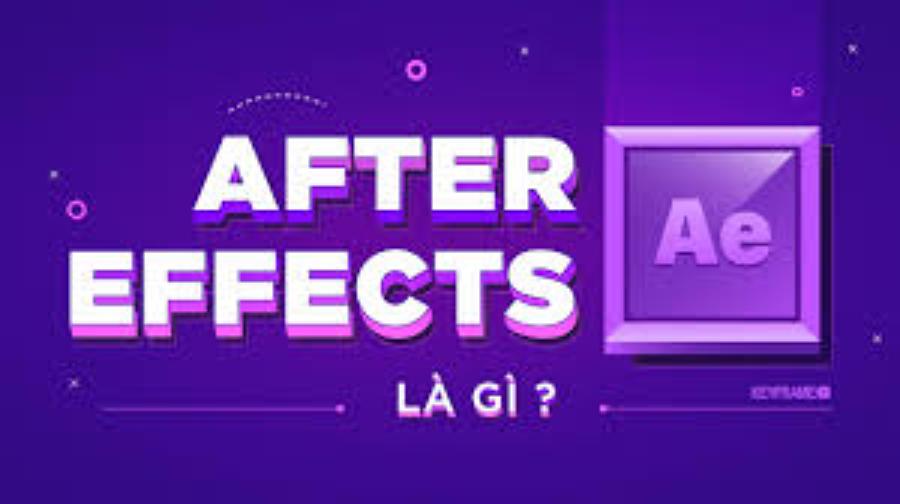Best Selling Products
What is After Effects? Information From A - Z About After Effects
Nội dung
- 1. What is After Effects?
- 2. How to learn After Effects effectively
- 2.1. Getting Started with the Basics of After Effects
- 2.2. Learn basic tools and techniques
- 2.3. Practice creating basic effects
- 2.4. Explore advanced effects
- 2.5. Build real projects
- 3. After Effects Learning Resources
- 4. Outstanding Features of After Effects
- 4.1. Creating Motion Graphics
- 4.2. 3D Tool Integration
- 4.3. VFX - Special Visual Effects
- 4.4. Video Editing and Cutting
- 4.5. Integration with Adobe Creative Cloud
- 5. Benefits of Using After Effects
- 5.1. High Flexibility
- 5.2. Support for Creating Custom Effects
- 5.3. High Compatibility With Other Software
- 6. Conclusion
Discover what After Effects is and how to learn After Effects from basic to advanced. This detailed article about graphics software will help you master the necessary skills.

After Effects is a famous graphics software of Adobe, mainly used to create visual effects and animations. In this article, Sadesign will help you understand what After Effects is, the applications of this software and how to learn After Effects effectively from basic to advanced.
1. What is After Effects?
After Effects is a professional graphics software developed by Adobe, featuring the ability to create animation effects, motion graphics, video editing and animation. This software is widely used in the video production industry, film, advertising, television and even personal creative projects. With strong support from Adobe, After Effects provides many powerful features that help users easily create impressive and unique effects.
.jpg)
History and development of After Effects
First launched in 1993, After Effects quickly became an indispensable tool in the graphics and visual effects industry. After many improvements and developments, After Effects is now one of the most popular and powerful software in the world in the field of graphic creation.
Outstanding features of After Effects
Special Effects : After Effects offers thousands of visual, audio, and motion effects that you can easily apply to your projects.
Video Editing : Users can easily edit and trim videos, add text, images and other graphic elements.
Motion Animation : This software allows you to create dynamic animations with detailed and precise control.
Create 3D images : After Effects supports the creation of 3D visual elements, which helps you create more striking and impressive effects in your videos.
Integration with other Adobe software : After Effects is compatible and easily combined with other Adobe software such as Premiere Pro, Photoshop and Illustrator, giving users a smooth and efficient workflow.
After Effects is a great tool for designers, video producers, and content creators to create high-quality creative products. If you are looking for a software to create videos, special effects, or dynamic animations, After Effects is an ideal choice.
2. How to learn After Effects effectively
.jpg)
Learning After Effects can be challenging for beginners, but with the right learning strategies and patience, you can master the software. Here are some steps to help you learn After Effects from basic to advanced.
2.1. Getting Started with the Basics of After Effects
Before you get started creating complex effects, you need to master the basics of After Effects. This includes getting familiar with the software's user interface, basic tools, and how to use them.
Understanding the
After Effects user interface After Effects can be quite complex for beginners. However, you only need to familiarize yourself with the main components such as timeline, composition, layer, panel, and basic effects. These sections will help you understand how to organize and edit videos in After Effects.
Understanding Layers and Compositions
Layers are an important part of After Effects. You need to understand how to add, edit, and organize layers in a composition. Composition is where you will build all of your video elements, from images, text, to effects.
2.2. Learn basic tools and techniques
once you're familiar with the interface, you can start learning how to use the basic tools in After Effects. Some of the popular and useful tools you'll use regularly include:
.jpg)
Pen tool : Used to create shapes, outlines, and vector graphics.
Shape tool : Allows you to create basic shapes such as circles, squares, polygons.
Text tool : Create text and apply motion effects to that text.
Keyframe : This is an important tool in After Effects, helping you create movement for objects in the video.
2.3. Practice creating basic effects
Once you understand the basic tools, you should start practicing creating simple effects. For example, you can try creating text animations, or some simple movements for images. This will help you understand how the tools work and how to combine them to create interesting effects.
2.4. Explore advanced effects
Once you have mastered the basic tools, it is time to explore the advanced effects in After Effects. The software offers a treasure trove of effects, from lighting effects, shadows to 3D effects and physics simulations.
Motion Graphics : Create complex graphic movements, this is often used in advertising, presentations or music videos.
Tracking and Masking : These techniques allow you to track the movement of objects in your video and create masking layers to highlight important elements.
Rotoscoping : This is a technique of separating the subject from the background, helping you create unique effects.
2.5. Build real projects
One of the most effective ways to learn After Effects is by practicing on real projects. You can create small videos or take on creative projects to apply the skills you have learned. Working on real projects will not only help you consolidate your knowledge but also help you develop your creativity and design thinking.
3. After Effects Learning Resources
To learn After Effects quickly and effectively, you need to use quality resources. Here are some resources to learn After Effects that you can refer to:
.jpg)
Online Courses : Platforms like Udemy, Coursera, or LinkedIn Learning offer courses from beginner to advanced levels on After Effects. These courses often come with detailed video tutorials and practice exercises.
YouTube Video Tutorials : YouTube is a huge free resource, with many video tutorials from experts in the field of graphic design and effects.
Online forums and communities : Communities like Reddit, After Effects forums, or Facebook groups dedicated to After Effects are places where you can interact, learn, and get your questions answered when you encounter difficulties.
4. Outstanding Features of After Effects
4.1. Creating Motion Graphics
After Effects stands out for its ability to create professional motion effects. Professionals can use the software to design animated logos, opening titles, transitions, and complex motion graphics elements. This helps give videos a dynamic look that engages viewers from the very first seconds.
4.2. 3D Tool Integration
Although After Effects primarily works with 2D graphics, the software also supports 3D tools, allowing users to create complex 3D footage. You can easily incorporate 3D elements into your videos, edit 3D cameras, lights, and shadows to create impressive depth effects.
4.3. VFX - Special Visual Effects
With After Effects, users can create professional visual effects (VFX) for film, commercial, or music video projects. Simulation tools for water, fire, smoke, fog, etc. can be used to add realism to the scene.
4.4. Video Editing and Cutting
In addition to creating effects, After Effects is also a powerful video editing tool. Users can perform operations such as video trimming, color correction, brightness adjustment, contrast adjustment and many other features to improve image quality.
4.5. Integration with Adobe Creative Cloud
After Effects works seamlessly with other software in the Adobe ecosystem, especially Premiere Pro. This allows users to easily convert files and optimize workflows. For example, you can create an effect in After Effects and quickly export the file for use in Premiere Pro.
5. Benefits of Using After Effects
5.1. High Flexibility
After Effects is an incredibly versatile tool that can be used for a variety of purposes, from creating effects, editing videos to creating complex animation projects. This allows creative professionals to take full advantage of the software's capabilities to complete their projects.
5.2. Support for Creating Custom Effects
This software provides a myriad of tools and features for users to create custom special effects. Not only that, After Effects also supports plugins to expand creativity and improve work efficiency.
5.3. High Compatibility With Other Software
Thanks to its tight integration with other software in the Adobe Creative Cloud suite, After Effects allows users to work seamlessly from one software to another without encountering compatibility issues. This reduces working time and increases work efficiency.
6. Conclusion
After Effects is a powerful tool that helps you create impressive videos and animations. To learn After Effects proficiently, you need to master the basics, practice a lot and find quality learning resources. Whether you are a beginner or have experience in the graphics field, learning After Effects will give you unlimited creative opportunities. Start your journey to learn After Effects today to create quality and unique video products. You can also refer to genuine graphic design software at Sadesign, it will help you a lot.












































